Barn Owl
European Barn Owl
Tyto-alba
These pale, nearly worldwide, birds are closely associated with man through their traditional use in the Old World of barn lofts and church steeples as nesting sites. Although widely known beforehand, it was in 1769 when the Barn Owl was first officially described by Giovanni Scopoli, an Italian naturalist. The species name “alba” also refers to the colour white. Other names for the Barn Owl have included Monkey-faced Owl, Ghost Owl, Church Owl, Death Owl, Hissing Owl, Hobgoblin or Hobby Owl, Golden Owl, Silver Owl, White Owl, Night Owl, Rat Owl, Scritch Owl, Screech Owl, Straw Owl, and Delicate Owl.
Description: The Upperparts are light grey with numerous fine dark lines and scattered pale spots on the feathers. There are buff markings on wings and on the back. The underparts are white with a few black spots, occasionally none. Feathering on the lower legs may be sparse. The heart-shaped facial disc is white with a brownish edge, with brown marks at the front of the eyes, which have a black iris. Its beak is off-white and the feet are yellowish-white to brownish. Males and females are similar in size and colour, females and juveniles are generally more densely spotted.
Size: Female: Length 34-40cm (13½-15½”) Wingspan 110cm (43″) Weight 570g (20oz)
Male: Length 32-38cm (12½-15″) Wingspan 107cm (42″) Weight 470g (15½oz)
Voice: The Barn Owl calls infrequently, the usual call being a drawn-out rasping screech. The courtship call of male at nest is a shrill repetitive twittering. Adults returning to a nest may give a low, frog-like croak. When surprised in its roosting hollow or nest, it makes hissing and rasping noises and snapping sounds that are often called bill snapping, but possibly made by clicking the tongue.
Hunting & Food: Barn Owls specialise in hunting small ground mammals, and the vast majority of their food consists of small rodents. In Australia, the introduced House Mouse (Mus musculus) forms the staple diet. In America and Europe, voles (field mice) are the single most important food, followed by shrews, mice and rats. Barn Owls breed rapidly in response to mouse plagues. Other prey may include baby rabbits, bats, frogs, lizards, birds and insects. Prey are usually located by quartering up and down likely looking land – particularly open grassland. They also use low perches such as fence posts to seek quarry. Barn Owls rely greatly on their silent flight and extremely acute hearing to locate prey. The sound of the Barn Owls wings are muffled by a velvety pile on the feather surface. In addition, the leading edges of the wing feathers have a fringe or fine comb which deadens the sound of the wing beats.
The silent flight prevents the Owls victim from hearing its approach, and also aids the Owls own hearing. The ear openings are at slightly different levels on the head, and set at different angles. They are covered by a flexible ruff made up of short, densely webbed feathers which frames the face, turning it into a dish-like reflector for sound. This gives the Barn Owl very sensitive and directional hearing, with which it can locate prey even in total darkness.
Breeding: Barn Owls will breed any time during the year, depending on food supply. In a good year, a pair may breed twice. Rodent plagues cause Barn Owl numbers to increase dramatically. During courting, males may circle near the nest tree, giving short screeches and chattering calls. The majority of Barn Owls nest in tree hollows up to 20 metres high. They will also nest in old buildings, caves and well shafts. 3 to 6 eggs are laid (occasionally up to 12) at 2 day intervals. The eggs are 38 to 46mm (1½-1.8″) long and 30 to 35mm (1.2-1.4″) wide and will be incubated for 30 to 34 days. Chicks are covered in white down and brooded for about 2 weeks, and are fledged in 50 to 55 days. After this, they will remain in the vicinity for a week or so to learn hunting skills and then rapidly disperse from the nest area. Young birds are able to breed at about 10 months.
Mortality: Barn Owls are short-lived birds. Most die in their first year of life, with the average life expectancy being 1 to 2 years in the wild. In North America the oldest known Barn Owl in the wild lived to be 11 years, 6 months. In Holland, a wild barn owl lived to be 17 years, 10 months old.
In England, a captive female barn owl was still breeding at 22 years old!
Habitat: The Barn Owl is found in virtually all habitats but much more abundantly in open woodland, heaths and moors than forested country. They usually roost by day in tree hollows but have also been found in caves, wells, out-buildings or thick foliage.
Distribution: The Barn Owl is one of the most wide-spread of all land birds. They are found on all continents (except Antarctica) and large islands and occur over the whole of Australia, including Tasmania. They occur throughout most of Britain and Europe and across many parts of Asia, Africa, and in much of North America. In South America they are found in areas of suitable grassland, as well as on oceanic islands such as the Galapagos. They were introduced to Hawaii in 1958.

